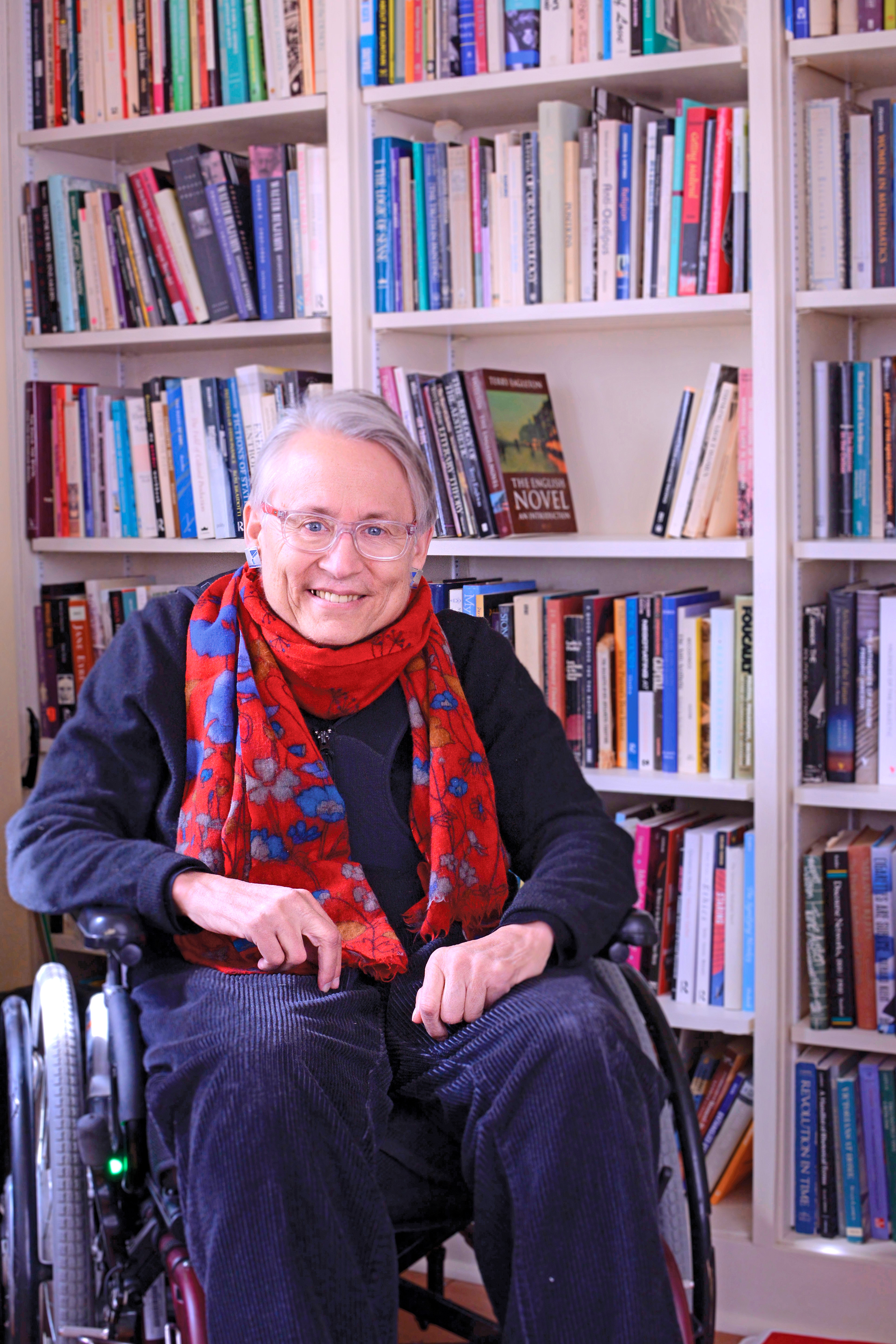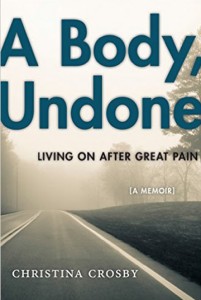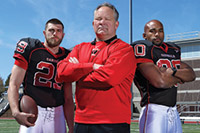CHRISTINA CROSBY: “A BODY, UNDONE”
Christina Crosby is a feminist, a lesbian, and a scholar of gender and sexuality, but the concept of embodiment—what it means to be in and of one’s body—was not just something she thought about, but something she lived.
As a child in rural Pennsylvania, she played, strong and coordinated, alongside her brother and competed fiercely with him—she even sometimes imagined herself his twin. In high school and college, she played field hockey and basketball, and began running after she graduated in 1974. At age 40, she turned to biking, and the year she turned 50 was hoping to reach over 1,000 miles, riding spring through fall. She reveled in the muscular body created through a lifetime of sport, and took pleasure in choosing tight leather pants and a silky sleeveless top when stepping out of an evening. “Embodied life was then an affirmation of fully realized pleasures integrated with a rich intellectual life,” she writes.

All that came crashing to a halt on October 1, 2003. As the Wesleyan English professor rode her bicycle in the dimming light that evening, a fallen branch caught in the spokes of her wheel just as she crested a hill, flinging the bike sideways. Crosby’s chin hit the pavement, which both smashed her face and broke her neck, leaving her with “quadri-plegia”—the medical definition for paralysis below the shoulders that involves all four limbs. Because her spinal cord was scraped, not severed (making the injury “incomplete”), she has recovered weak but functional arm strength and limited use of her hands.
Suddenly hers was—as the title of her newly released memoir says—A Body, Undone. An accomplished writer and a lover of prose, who urges her students to use language precisely, Crosby found herself struggling for words to explain her body and her life. She writes: “How was I to describe this pain, lost in a body so foreign to me I would translate it into speech in only the most primitive way?”
But over the years since Crosby’s accident, the words have come and gathered into a memoir. The book is a series of direct and revealing essays that tell a story of pain and grief, but also of passionate love, the support of a vibrant community, and her driving desire to live. Crosby brings all of her gifts to bear—a brilliant mind, an unflinching ability to analyze and report on her physical life, including even the “bowel program” necessitated by compromised bowels, her love of sex both before and after the accident, and the frustration of trying to connect with her much-loved dog when she came home in a wheelchair that scared poor Babe.
Crosby’s story starts in rural Penn-sylvania, where her father was a professor at Juniata College, a small liberal arts school run by the Church of the Brethren. She went on to undergraduate work at Swarthmore College before earning a PhD in English at Brown University. Crosby landed at Wesleyan in 1982. By the time of her crash, she was the chair of the faculty, preparing for a meeting with the trustees. She had published a book on Victorian society and “the woman question,” and had won a major teaching award. In her office one of the only wall hangings is the certificate from that honor.
In the six years before the accident, Crosby had been in a relationship with Janet Jakobsen, a Barnard College professor of women’s, gender and sexuality studies and the director of the Barnard Center for Research on Women. Their love remains a defining force in Crosby’s life today and continues to sustain her.
When Crosby awoke from sedation after the accident to find herself paralyzed, a cruel fate decreed that she knew better than most what that meant. Her beloved only sibling Jeff had been living with multiple sclerosis for decades at the time of her accident. Crosby had watched his erect, handsome body change over time. First he used a cane, and then a convenient, light, folding wheelchair. Then, as he lost arm function, he needed a power chair. First he sat up straight, but gradually slumped forward as muscles in his midsection wasted away. By the time she broke her neck, Jeff was already quadriplegic. “In an instant,” Crosby writes, “at the symbolic age of 50 . . . my childhood fantasy of being his twin seemed malevolently realized.” But, no. Jeff’s body continued to fail. He lived long enough for the siblings to sit side-by-side in their wheelchairs, and to exchange emails about bodily functions—a conversation Crosby never imagined she would have with her brother. He died in 2010.
Crosby, like her brother before her, found joy and connection in the support of a loving community. In a culture where we like to see ourselves as independent, self-sufficient, Crosby insists on interdependence. The necessity of the support of people from Wesleyan, both in the immediate aftermath of her accident and in the years since, is clearly detailed in the book. At the time of the crash, Jakobsen was in New York. On the train ride north she worried that her love lay suffering alone. But when she arrived at Hartford Hospital she found Wesleyan’s then-president Doug Bennet and his wife, Midge, in the waiting room.
Crosby writes, quoting Midge, “We’ve been able to see her. They asked, ‘Are you her parents?’ and I just lied.” At that, Jakobsen burst into tears. The couple would be sustained by the love of the whole Wesleyan community—so importantly represented by Doug and Midge at the moment of crisis—through meals, rides to therapy, and good wishes through the two full years of rehabilitation required before Crosby could return to work half-time.
Even so many years since her accident, help continues to be crucial. Simple chores—going to the departmental office in the building next door to collect your mail—take on a different level of challenge when one must negotiate multiple floors, elevators, and tight turns in a wheelchair. Margaret Neale adds three hours a week to her full-time job in the Office of Financial Aid to help Crosby prepare for classes and manage the details of a complex life. Liz Tinker, administrative assistant in the English Department, will bring Crosby her mail rather than having her go from one building to another. If the ramp on the specially modified van Crosby drives fails to go up or down, it is often Tinker who goes outside (in the rain, of course) to help Crosby get to where she needs to go.
But Tinker is quick to say that Crosby doesn’t complain. “She has so inspired me in how she has dealt with this incredible tragedy that would put anyone else to. . .” Tinker’s voice trails off as she struggles for the right word. “She is so insistent on doing everything possible by herself. She hates to ask for help, but also relies on us when she needs to. There is nothing that I or anyone else in the department wouldn’t do for her.”
During a recent interview in her office, both Crosby’s continuing challenges and the progress she has made since the initial injury are obvious. Dressed in all black (“Maybe I am in permanent mourning,” she writes.), but for a bright scarf and geometric earrings, she has mobility in her arms such that she can gesture as she speaks. But her hands are slightly gnarled in on themselves and she writes by using voice recognition software.
One might wonder why Crosby has chosen to tell the story. Why dig deeply into intimate bodily functions and excruciating pain? In a way the book reads almost as therapy, exploring impossible-to-solve dilemmas and outright contradictions. Immediately after the accident, for example, Crosby tells us that Jakobsen reported to their friends that she had “suffered no loss of [her] ‘personhood,’’’ but Crosby nonetheless feels alien, even unrecognizable, because, she says, “My sense of a coherent self has been so deeply affronted.” Her 50 years of life before the accident and her desire to remember the bodymind she so long had mean that “forgetting is impossible,” yet she also recognizes that “forgetting is also imperiously necessary. In order to live on I must actively forget the person I once was, and be committed to forgetting more mindfully than you probably are as you go about your daily life.”
“It’s a real contradiction. It’s not a paradox. It’s a flat-out contradiction. I need to do two things imperatively and they conflict,” she says.
But perhaps the main motivation for sharing her story, in all its raw details, is to open others’ eyes to what life with a disability is like, to make space for the accommodations that make a life like Crosby’s not just possible, but valuable. “One of the things about the disability experience is that it is highly privatized,” Jakobsen says. “People don’t know much about disabled lives. You are not supposed to be in the public sphere.”
Making a world that works better for people with disabilities would also be good for the able-bodied, Jakobsen says. She and Crosby see this simple fact as they navigate the streets around Jakobsen’s New York apartment: curb cuts exist, but pedestrians with carts and parents pushing strollers flow around Crosby’s wheelchair as everybody tries to make it through the same tiny slice of sidewalk before the light changes. In New Haven, where the whole corner of the sidewalk slopes to the street, anything with wheels can roll off the sidewalk at any spot—a simple design improvement with dividends for everyone. Jakobsen pointedly notes that such structural modifications are called “universal design” because they are useful to all.
Other details impact Crosby alone. Crowded rooms are impossible to navigate, because the wheelchair is so large. Crosby writes about attending a party a few years ago at a house she had not been to since the accident. She arranged for a friend to help her set up an extendable ramp she carries in her van that would allow her to surmount the concrete stoop and get into the vestibule. The party was a great success and the rooms were packed. Although friends made their way by to say hello, the food and fun remained mostly inaccessible. “I left after about an hour and went home, sober and sad,” Crosby writes.
As Crosby is quick to point out, both in her book and in person, she is nonetheless very, very fortunate. She and Jakobsen can afford to employ a dedicated home health aide (the same woman, Donna, has been helping Crosby ever since she returned home). They could afford modifications to make their home accessible. She returned to teaching and writing halftime and is able to work because her livelihood involves language, work that can be done with limited mobility.
But mobility is not where the challenges end. “Paralysis is often thought to be an issue of mobility—‘Will he walk? Will she walk?’ Mobility is where paralysis meets the public eye,” Crosby says. “Paralysis entails so much more and that’s why I wrote the book, because I feel that otherwise I would be fundamentally misrecognized—unless people understand what it takes to live with damage to the central nervous system. Central nervous systems can be damaged in a whole host of ways, but however it is done, you are going to have troublesome bowels. You are not going to be able to control your urine. Your sex life will be radically different. You may or may not be plagued with neuropathic pain. If you are a quadriplegic, as my brother and I both were, you are not going to be able to grasp things and have fine motor control. You are no longer going to be able to pick things up. You are no longer going to be able to sign your name. You lose so much of yourself. That means you need to reinvent yourself. You need to become something else and yet retain who you were.”
Often when one suffers a life-changing injury like Crosby’s, people focus on how that person has triumphed over tragic events and gained a new appreciation of the really important things in life. But what Crosby’s book—and indeed her life—show instead is a person who was already thoughtful and intentional, and very, very real.
“The most defining thing about Christina is her generosity toward people,” says Sally Bachner, an English professor whose office is immediately next to Crosby’s. “When Christina is part of a meeting you know it will be a meeting with open, generous, intelligent debate.”
“To me the most important thing is Christina’s spirit, her will to live, her joy in life, her recognition that joy is only accessible if you recognize the grief, too,” Jakobsen says. “She has a tremendous dedication to the project of making her life anew.”
That may be Crosby’s defining accomplishment—in her book, in her teaching, in her presence in the world. In, as she writes, “diving into the wreck of my body” she has illuminated what comes from the messy, painful, beautiful truth: Grace, embodied.
From A Body, Undone
 I needed to enter language and engage my learning in an active, creative way. To my surprise, I began writing in the first person. I wrote to refine my memories of the body I had been and the life I had lived, all of which made up the bodymind I was that day I set off on my last bike ride. And I also wrote to articulate the life that has come to me since, linking my irrevocably sundered past to the present so that I might face the future. I rejoiced in the way sentences pushed forward from subject to predicate, and tropes turned my thinking in creative directions I had no notion I’d go. Finally, writing brought me in the end to the beginning: the moment in the rehab hospital when I was able to imagine a future of independent activity directed to ends I desired.
I needed to enter language and engage my learning in an active, creative way. To my surprise, I began writing in the first person. I wrote to refine my memories of the body I had been and the life I had lived, all of which made up the bodymind I was that day I set off on my last bike ride. And I also wrote to articulate the life that has come to me since, linking my irrevocably sundered past to the present so that I might face the future. I rejoiced in the way sentences pushed forward from subject to predicate, and tropes turned my thinking in creative directions I had no notion I’d go. Finally, writing brought me in the end to the beginning: the moment in the rehab hospital when I was able to imagine a future of independent activity directed to ends I desired.
When I was rehabilitating at the Hospital for Special Care, paralysis had so weakened my hands that I couldn’t turn a page of the Penguin paperbacks that line the bookshelf in my study. As you know, I was unable even to grasp a Kleenex and move it from right to left on my tray table when Patty instructed me to do so. I cried tears of despair and rage, bitter tears. Day after day in therapy, I very slowly strengthened my grip as I followed her instructions.
Several months after she had tried the tissue, Patty returned with a pencil and a book. She opened the book flat before me, and holding the pencil with the eraser facing outward, used it to grab the edge of a page. She turned it over. Then she handed the pencil to me. I grasped it with all my strength, and as Janet and my nurse, Winnie, watched, I turned a page. “I have my life back,” I said with tears overflowing. I said again, “I have my life back,” and we all four cried together.

